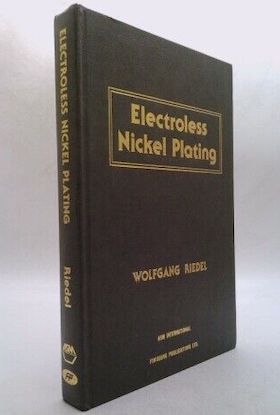
-----
Stripping Nickel off Stainless Steel Substrates
Q. I have a plastic coated cathode shaft which has a stainless steel extension piece added to increase the overall length of the shaft. The extension is covered by a polypropylene sleeve with O-ring to stop the nickel plating from entering the threaded connection of these two pieces. Unfortunately some nickel plating has seeped in and it's now not possible to unscrew the extension from the cathode shaft.
I've been researching various methods of dissolving nickel plating and I can't be sure that the steel cathode shaft and the extension piece will not also dissolve. Can anybody recommend a method to dissolve the nickel plating without affecting the steel? I'm happy to sacrifice the polycarbonate sleeve so this is not an issue.
- Sydney, NSW
June 15, 2021
A. Hello Darren
Some mixes of Cyanide and Nitrobenzenesulfonic acid salts will strip Nickel safely from steel and stainless steel substrates. Ask your chemical suppliers, as sometimes it is sold as proprietary "stripping salt" to be added to Sodium Cyanide bath.
Good luck,
- Winnipeg, Canada
⇩ Related postings, oldest first ⇩
Q. We are an EN shop. We were stripping nickel from a large 4140 substrate. The result was a purple precipitate that seems like it's baked into the substrate now. We have never seen such a phenomenon. We suspect that parts, done previously in the same stripper, with some black oxide film on them may be the culprit. Would anyone have any suggestions as to what it is and how it was caused? As well as how to remove it? Yours truly,
Austin Hirtle- Mississauga, Ontario Canada
2000
A. Sorry, this is a new one on me as well, Austin. If you have a scrap test part, you might try dipping it in chromic acid. For reasons that I don't fully understand, it seems to have some ability to remove stains which nitric acid lacks.
Another thought is that stainless, like titanium, can have a very thin partial wavelength oxide coating which, although actually transparent, looks purple or another color because light bounces off both the surface and the substrate and interferes. You might look at letter 33236 or contact a stainless steel anodizing specialist like Prismatic Stainless Steel [from B&M Finishers, a finishing.com supporting advertiser] to see if they agree what this might be an anodized layer and find out how it can be best removed.

Ted Mooney, P.E.
Striving to live Aloha
finishing.com - Pine Beach, New Jersey
Ted is available for instant help
or longer-term assistance.
Q. I would like to strip nickel (no semi-bright nickel) from stainless steel 304 without effect on substrate other than nitric acid.

Popatbhai B. Patel
electroplating consultant - Roseville, Michigan
2002
A. Contact Macdermid and ask them about the Elnic strip that removes accumulated electroless nickel from stainless steel tanks. It's a hydrogen peroxide / sulfuric acid mixture and works well in place of nitric.

Milt Stevenson, Jr.
Plating shop technical manager - Syracuse, New York
Q. Hello ... I want to how can I unstitch a nickel layer from stainless steel. Can you give me a chemical formula?
Sincerely ... I look forward your answer.
Alaattin Tunaan electroplating company - Turkey
2003
A. Dear Mr. Tuna,
You can strip nickel from stainless steel with 500 ml/l nitric acid(53%).
Kind regards,

Sjamp van Esch
- Eindhoven, The Netherlands
Q. My name's Dante and I'm working on getting a Copper Plating manufacturing line fully running. We've got it to a point where we can produce copper plated stainless steel substrates. However, I'm having a problem where there are some that are messed up, and I can put them through the line again, but I need to strip both Nickel and Copper off the substrate (the substrate is 14" in diameter, it's stainless steel, and gets plated with electroplating, first a thin layer of nickel and then a thin layer of Copper over the nickel). The actual production is doing fine.
However, I am trying to work out how to strip the nickel and copper off the stainless steel substrate. What I usually do is give it to a shop and have them strip it, however the shop is far from where I am and sometimes takes too long. I know that there is a way to strip it, and doing it in house would probably be faster (no other orders in front of mine) and cheaper (less driving and not having to pay someone to do it for me).
I tried to find a simple way of doing it on the Internet and didn't find anything really that would help. There was one thing that mentioned Nitric Acid, but wasn't very informative on the procedure.
If someone could point me in the right direction, that would be great.
Thanks.
plating shop foreman - Ventura, California
August 5, 2009
|
A. First, I would try to figure out what is causing the rejects. Reworks are horribly expensive. - Navarre, Florida A. Dante, Aerospace - Yeovil, Somerset, UK |
A. The mention of nitric probably wasn't very informative because there's not much to it.
Dilute 42 Be nitric acid with no more than 50% de-ionized water, submerge your nickel-plated parts and let sit for a few hours. Nitric at this strength won't harm the stainless. I usually use nitric for cleaning off racks.
There are also some proprietary nickel-strip solutions out there, that are biodegradable. I can't give you brand names, but they work great. They're a bit easier to work with, too. Nitric can be nasty. It smells bad, can react violently (releasing brownish NO2 gas) and it stains your skin yellow.
- Toledo, Ohio
![]() Dear All, thank you for your responses. I will do some more research into the proprietary brands and also see what it would take to go to through the Nitric Acid route.
Dear All, thank you for your responses. I will do some more research into the proprietary brands and also see what it would take to go to through the Nitric Acid route.
Dante
- Camarillo, California
Stripping nickel coating from nickel base
Q. Hi
I am an engineering student from Turkey.
I would like to remove/strip the nickel coating (Electroless Nickel) from Inconel alloy 718 (Nickel Base).
What is the suitable stripper to use for removing this coating?
Hope to get some help.
Thanks in advance.
- Istanbul, Turkey,
October 22, 2015
A. Nickel stripping solutions can't tell the difference between nickel plating and nickel alloy so there is no effective way of stripping. If the parts were plated correctly, there should be a copper layer over the alloy 52 for this exact reason.
Casey Weizel, PresidentForesight Finishing LLC
- Tempe, Arizona

Q, A, or Comment on THIS thread -or- Start a NEW Thread

